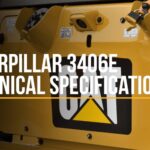The Caterpillar C15 engine, particularly the MXS configuration, is a popular choice for heavy-duty applications. Building an Mxs Cat Engine with reliability and power in mind requires careful component selection and assembly. This guide outlines the key considerations and recommendations for building an MXS Cat engine optimized for both performance and longevity.
MXS Lower End: The Foundation for a Robust Engine
The MXS lower end provides a solid foundation for a powerful and reliable engine. It features a stronger, higher-quality casted cylinder block compared to the 6NZ. While crankshafts are similar between the MXS and 6NZ, the MXS boasts stronger connecting rods with four rod bolts instead of two. Utilizing industrial piston packs from a JRE C15 engine allows for a lower compression ratio (16:1), similar to the 6NZ, enhancing both power and reliability.
Key Component Considerations for the MXS Cat Engine
Several key components significantly impact the performance and reliability of an MXS Cat engine build:
Pistons: Opt for One-Piece Steel
One-piece MXS steel pistons are crucial for durability. These pistons withstand higher power levels and offer superior reliability compared to the two-piece steel crown and aluminum skirt design found in the 6NZ. The MXS lower end also incorporates a more efficient cooling system, featuring a larger water pump for improved heat management under heavy loads.
Cylinder Heads: Choose New Casted Options
Avoid remanufactured Caterpillar cylinder heads due to their susceptibility to cracking. New aftermarket casted cylinder heads with thicker casting between the valves eliminate this common issue and are compatible with both MXS and 6NZ engines.
Injectors: Flow Matching for Optimized Performance
Using 10R8502 injectors with flow matching ensures optimal fuel delivery and smooth idling. Flow-matched injectors contribute to efficient combustion and improved engine performance.
Programming: Stick with Proven Solutions
Avoid aftermarket programming, as it often leads to head gasket issues. A reliable option is the 6NZ 550 HP program, which provides a balance of power and dependability. While this program might produce higher exhaust gas temperatures (EGTs), mitigating this can be achieved through a larger turbocharger and a ceramic-coated aftermarket exhaust manifold.
Camshaft: Enhancing Reliability
Using the larger 10R7155 camshaft further enhances engine reliability. This component contributes to the engine’s overall durability and performance.
Building a 630 HP MXS Cat Engine
Combining the recommended components, including a larger turbocharger, flow-matched injectors, and the bigger camshaft, can yield impressive power output in the 630 HP range.
Conclusion: Building Your MXS Cat Engine
Building a powerful and reliable MXS Cat engine involves careful selection of key components. Prioritizing quality parts, such as the MXS lower end, one-piece steel pistons, new casted cylinder heads, and flow-matched injectors, ensures long-lasting performance. Utilizing a proven programming solution and upgrading the camshaft and turbocharger contribute to a robust and efficient engine capable of handling demanding applications. Remember to consider emissions regulations and always consult with experienced professionals for guidance. Building from an existing 6NZ engine is a recommended practice.

